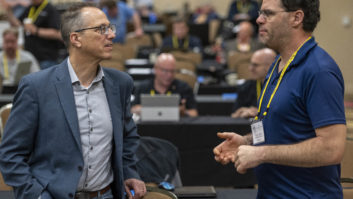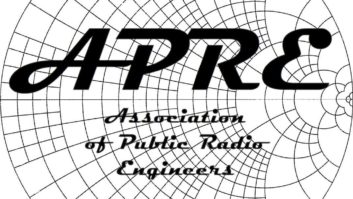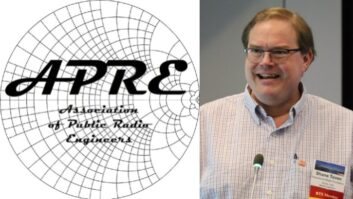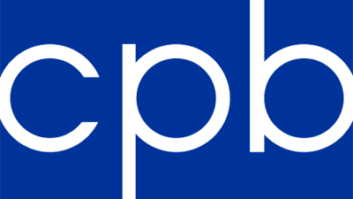Ed. Note: After the story below was published, engineers decided to launch the association; see http://www.rwonline.com/dailynews/one.php?id=9090
Public radio engineers are close to deciding whether to form a Public Radio Engineering Association. In May, several sources told Radio World the engineers were leaning towards doing so.
Organizations exist to represent the interests of other public radio professionals, including those in development, management, programming and news. It’s time, backers say, for engineers to be represented by an entity concerned about their unique needs.
Mike Starling, vice president and chief technical officer for NPR and executive director of NPR Labs, broached the idea with two others: Ralph Hogan, assistant general manager of engineering services at Washington State University, licensee of Northwest Public Radio; and Dan Mansergh, director of engineering at KQED(FM) in San Francisco.
Hogan and Mansergh, who is also a Radio World contributor, have agreed to serve as chair and vice-chair, respectively, of the prospective organization.
‘Long overdue’
Starling called the formation of such an association long overdue and said the group would have the support of NPR Labs, NPR Engineering and the Public Radio Satellite System in working to focus on system-wide engineering priorities.
Yet the membership base would not be limited to those who work at NPR member stations, but open to all public radio station engineers. In preliminary talks, Hogan and Mansergh discussed a requirement that members work at CPB-qualified stations, but felt that was too limiting. They have proposed using the PTFP language of applicant eligibility. “The goal is to make it as accessible as possible,” said Mansergh.
How many members might a PREA represent? Mansergh estimated the number of people directly involved in engineering functions at public stations at roughly 500 to 600. That doesn’t include mixing engineers and several thousand others in supporting roles at public radio networks and elsewhere in the industry who could be potential members. The classes of membership to be offered haven’t been discussed, he said.
The main goals of PREA would be to plan the annual Public Radio Engineering Conference, currently co-managed by NPR Labs and PRSS; advise and advocate on public radio engineering issues; develop a repository for technical resources for public radio engineers; and establish a training and development program.
While the latter goal might seem to duplicate training efforts offered by the SBE, Hogan said PREA would “in no way compete with SBE. If anything, SBE would be a good support for this organization.”
Hogan sits on the SBE’s National Certification Committee and served two terms on the board of directors and two terms as secretary.
SBE President Chriss Scherer said the question of whether a PREA would duplicate SBE efforts was one of the first the board asked when briefed by Hogan. “We’re waiting to see if the group gets any legs” before saying much about it, Scherer said. He said he sees the potential for the groups to work together on some issues.
Something the group would not do is function as a union, its organizers say. PREA’s role would be to support members in their work through information, communication and collaboration, and to encourage a new generation to join the profession through outreach and educational opportunities, said Mansergh.
“If an issue were significant enough to warrant the organization taking a position and advocating a particular outcome, it may well do that, but that would not be its primary function. Direct work with station managers would be rare (and) project-related; and PREA would not act as advocates for specific members in negotiations like a union,” he said.
‘One voice’
The PREA concept appeals to at least some public radio engineers.
John Holt, director of engineering and operations for WAMU(FM) in Washington, said, “As a 34-year veteran of public radio I would like to see the public radio engineering fraternity speak with one voice as an independent organization representing the smallest stations and the largest organizations.
“I know that there is concern about the need for another organization with overlapping membership and agenda,” he continued. “But the needs of public radio engineers are different from commercial radio engineers and from television engineers. This doesn’t take away from one organization or another but adds to the knowledge base and provides for more input, a unified input, on the issues before the broadcasting community.”
Any training offered by PREA would be specific to public radio engineering’s needs, Mansergh said.
Offering an example, he said, “One of the key things we’re talking about: As we look at the ContentDepot rollout, the level of expertise between stations is unbalanced.”
PRSS has conducted training seminars and published a great deal of material on how to implement its impending updated program distribution method, but some stations will need more help than others to implement it.
Mansergh mentioned a public radio station on an Indian reservation in Northern California that his station has helped connect to the satellite distribution system. Right now, without an engineering association to help, such a station would simply find ContentDepot gear showing up on their doorstep – the interconnected station wouldn’t know what to do with it, he believes.
“They’ve got to have some support. There’s a lot of expertise here and a lot of people willing to help all over the country.”
Technical repository
PREA initially would post material on the NPR Labs Web site and possibly eventually have its own site, Hogan and Mansergh said. A site could include archived material from a public radio engineering list server to form a repository of technical information, said Mansergh.
A PREA also would help nurture the interests of younger people interested in engineering for public stations, s aid Hogan. Mansergh thinks the group might serve as a single source of help for CPB scholarship applications to the PREC convention, rather than the current set-up, in which NPR Labs and PRSS both handle that function.
The PREC convention, begun six years ago after the demise of the Public Radio Conference, has grown from 97 participants to more than 230 this year. Twenty-five of those were CPB scholarship recipients.
If formed, PREA would assist in planning that convention next year and possibly take over that function within two years. Both Hogan and Mansergh said starting the conference planning earlier is a priority.
An advisory group that includes 20 station engineers helps plan the PREC. (Radio World Engineering Extra Technical Editor Michael LeClair, chief engineer of the WBUR Group in Boston, is a member of the advisory committee.) It’s hoped the members of the advisory committee would form the core of PREA, and membership would build from that point.
Hogan has two TV stations and 13 radio stations under his purview at Northwest Public Radio and is on the PBS conference planning committee. He sees “synergies between the two groups we could capitalize on. There are a number of joint licensees who would like to go to both.”
The PREC shared space with the PBS convention this year.
Hogan stressed that the group faces many decisions and obstacles. It needs volunteers and would have to settle grittier questions such as a board and dues.
Of 50 surveys filled out at the PREC by participants, 49 said an association is a good idea. The one who was opposed felt the new group would duplicate efforts of the SBE, said Hogan.
Hogan and Mansergh planned to poll a wider group of public radio station engineers by the end of May, to gauge interest, and possibly begin forming committees to work on the groups’ basics, such as bylaws. More information about the group was expected to be available on the NPR Labs site ( www.nprlabs.org ) by early June.











